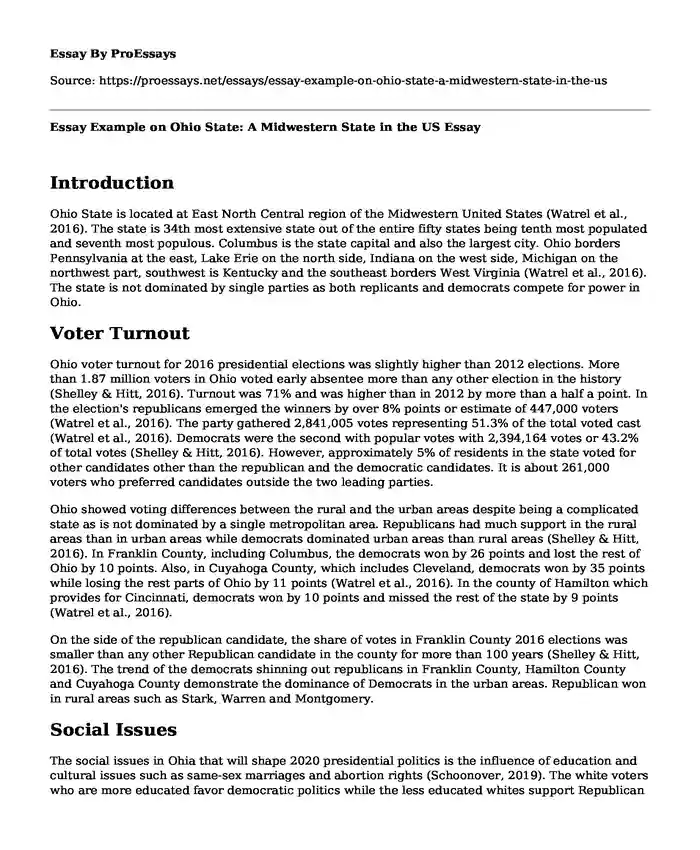Introduction
Ohio State is located at East North Central region of the Midwestern United States (Watrel et al., 2016). The state is 34th most extensive state out of the entire fifty states being tenth most populated and seventh most populous. Columbus is the state capital and also the largest city. Ohio borders Pennsylvania at the east, Lake Erie on the north side, Indiana on the west side, Michigan on the northwest part, southwest is Kentucky and the southeast borders West Virginia (Watrel et al., 2016). The state is not dominated by single parties as both replicants and democrats compete for power in Ohio.
Voter Turnout
Ohio voter turnout for 2016 presidential elections was slightly higher than 2012 elections. More than 1.87 million voters in Ohio voted early absentee more than any other election in the history (Shelley & Hitt, 2016). Turnout was 71% and was higher than in 2012 by more than a half a point. In the election's republicans emerged the winners by over 8% points or estimate of 447,000 voters (Watrel et al., 2016). The party gathered 2,841,005 votes representing 51.3% of the total voted cast (Watrel et al., 2016). Democrats were the second with popular votes with 2,394,164 votes or 43.2% of total votes (Shelley & Hitt, 2016). However, approximately 5% of residents in the state voted for other candidates other than the republican and the democratic candidates. It is about 261,000 voters who preferred candidates outside the two leading parties.
Ohio showed voting differences between the rural and the urban areas despite being a complicated state as is not dominated by a single metropolitan area. Republicans had much support in the rural areas than in urban areas while democrats dominated urban areas than rural areas (Shelley & Hitt, 2016). In Franklin County, including Columbus, the democrats won by 26 points and lost the rest of Ohio by 10 points. Also, in Cuyahoga County, which includes Cleveland, democrats won by 35 points while losing the rest parts of Ohio by 11 points (Watrel et al., 2016). In the county of Hamilton which provides for Cincinnati, democrats won by 10 points and missed the rest of the state by 9 points (Watrel et al., 2016).
On the side of the republican candidate, the share of votes in Franklin County 2016 elections was smaller than any other Republican candidate in the county for more than 100 years (Shelley & Hitt, 2016). The trend of the democrats shinning out republicans in Franklin County, Hamilton County and Cuyahoga County demonstrate the dominance of Democrats in the urban areas. Republican won in rural areas such as Stark, Warren and Montgomery.
Social Issues
The social issues in Ohia that will shape 2020 presidential politics is the influence of education and cultural issues such as same-sex marriages and abortion rights (Schoonover, 2019). The white voters who are more educated favor democratic politics while the less educated whites support Republican politics. The demographics in Ohio show a large portion of voters are white, older and less educated and therefore are more likely to support Republican candidates in 2020 elections (Schoonover, 2019).
People in Ohia vote much on culture issues than economic matters meaning they will support the republicans despite the need for change (Schoonover, 2019). The president has made the Republican party look more populist cultural party and winning the votes of Ohioans. Further, Trump has delivered in Ohio, and they will have no choice other than supporting the Republican candidate in the 2020 presidential elections (Schoonover, 2019).
Conclusion
Ohio is an economic state ranked eighth out of the fifty states in terms of GDP (Schoonover, 2019). Ohio is also the third state in terms of manufacturing. The country was initially an industrial powerhouse. However, it transitioned to a more information and service dominated economy. The political capital in Ohia is low as both democrats and republicans are capable of competing in the state (Shelley & Hitt, 2016). In 2012 Democrats won in Ohio, in 2016 Republicans won in the same state; therefore, none of the parties has dominated political capital in Ohio (Schoonover, 2019).
References
Schoonover, N. (2019). Ohio newsletter seeks to amplify Midwestern voices. Gateway Journalism Review, 48(355), 24-25.
https://go.gale.com/ps/anonymous?id=GALE%7CA610843969&sid=googleScholar&v=2.1&it=r&linkaccess=abs&issn=21587345&p=AONE&sw=w
Shelley, F. M., & Hitt, A. M. (2016). Purple states in the 2016 presidential election. The Geography Teacher, 13(3), 124-127.
https://www.tandfonline.com/doi/abs/10.1080/19338341.2016.1197142?journalCode=rget20
Watrel, R. H., Weichelt, R., Davidson, F. M., Heppen, J., Fouberg, E. H., Archer, J. C., ... & Martis, K. C. (Eds.). (2018). Atlas of the 2016 Elections. Rowman & Littlefield.
Cite this page
Essay Example on Ohio State: A Midwestern State in the US. (2023, Oct 17). Retrieved from https://proessays.net/essays/essay-example-on-ohio-state-a-midwestern-state-in-the-us
If you are the original author of this essay and no longer wish to have it published on the ProEssays website, please click below to request its removal:
- Essay on Psychological, Sociocultural, and Political Factors in the Development of Terrorism
- 2 Dollars a Day: Poverty in America Paper Example
- Research Paper on The Challenges Facing the Social Housing Sector
- Markets Reform, and Underground Railroad Essay Example
- Audism: Discrimination Against Hearing-Impaired People - Essay Sample
- Essay Example on Marco Polo: A Brief History of the Explorer
- Ethics of Information Technology: Balancing Surveillance, Privacy, and Social Welfare - Paper Example







